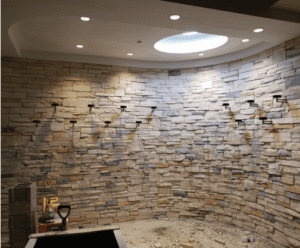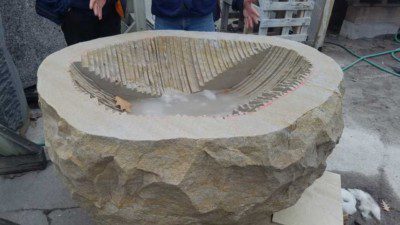Basket Blessing
In many Eastern European countries, it is a tradition to have a basket of food blessed on Holy Saturday or Easter Sunday. In Poland, for example, the blessing of the baskets is known as święcenie pokarmow wiełkanocnych, a practice dating to the 15th century or earlier, and one which is still maintained by most families in Poland, and to some extent in other countries, on Holy Saturday. The blessed foods have special significance.
A typical Eastern European Easter basket would include any of these symbolic foods:
- Bacon; A symbol of the abundance of God’s mercy
- Easter bread; a round cake of rich, eggy, yeast dough with raisins reminiscent of the risen Lord. Butter; Dairy products are included to celebrate the end of Lent and the richness of our salvation. Butter is often shaped into a lamb (symbolic of the Paschal Lamb).
- Candle; the candle symbolizes Jesus, the “light of the world”.
- Cheese; a symbol to remind Christians of moderation.
- Colored eggs; both colored and uncolored hard-cooked eggs indicate hope, new life, and Christ rising from his tomb.
- Ham; meats are symbolic of great joy and abundance in celebration of Christ’s resurrection.
- Sausage; the sausage links are symbolic of the chains of death that were broken when Jesus rose from the dead, as well as of God’s generosity.
- Horseradish; is a reminder of the bitterness and harshness of the Passion of Jesus, and the vinegar it is mixed with symbolizes the sour wine given to Jesus on the cross. Salt adds zest to life and preserve us from corruption.
- Sweets; suggest the promise of eternal life or good things to come.
Priest Vestments
The Church’s liturgical norms prescribe specific vestment colors for various celebrations. Colors highlight the particular liturgical season and the faithful’s journey through these seasons. Colors also punctuate the liturgical season by highlighting a particular event or particular mystery of faith. There are currently six liturgical colors. Gold and silver are allowed on special occasions. Violet/purple symbolizes penance, preparation, sacrifice. It is used in Advent, Lent and may be used for funeral Masses.
Purple originally was associated with royalty, because it was a more expensive color to dye. Over time, it became associated with penance.
White symbolizes purity, joy, light, glory. It is used during the Christmas and Easter seasons; Holy Thursday; the solemnity of the Most Holy Trinity; the feasts of Our Lord (excluding those relating to His passion), the Virgin Mary, the angels and the saints who are not martyrs. White is used at nuptial Masses and baptisms, and may be used at funerals. Green symbolizes hope, life, anticipation. It is used during Ordinary time, a season focused on the Lord’s three-year public ministry, His teachings and miracles; a reminder that the mission of the church is to share the hope and life of Christ with the world.
Rose symbolizes anticipation, rejoicing. It is used on Gaudete Sunday (the third Sunday of Advent) and Laetare Sunday (fourth Sunday of Lent). These Sundays occur at the midpoint of Advent and Lent and are a reminder of the upcoming joyful events. They also offer a “change of tonality” within the respective seasons.
Red symbolizes blood, fire and passion. It is used on Palm Sunday, Good Friday, and the feasts days of martyred saints as a symbol of the blood shed by Christ and the martyrs. As a symbol of the Holy Spirit and the burning fire of God’s love, red also is used on Pentecost Sunday, the sacrament of confirmation and the votive Masses of the Holy Spirit.
Black symbolizes death and mourning. It may be used at funeral Masses, the feast of All Souls or the anniversary of the death of a loved one.
Stained Glass
“Light is a common spiritual theme in Christian theology. In Genesis God’s first words at creation were, “‘Let there be light’; and there was light. And God saw that the light was good” (Genesis 1:3-4). Jesus even went so far as to identify himself with light, saying, “I am the light of the world; he who follows me will not walk in darkness, but will have the light of life” (John 8:12).
With this in mind it is fitting for Christians to spend much time and energy developing the design of windows in churches. Windows funnel the light of the sun and dispel the darkness of the shadows. Architects saw them as the perfect opportunity to highlight a spiritual truth while serving a functional purpose. However, stained glass windows as we know them today were not developed until the 10th century.
Stained windows not only served the spiritual purpose of bringing to mind how the light of God shatters our darkness, but also proved to be an important catechetical tool. It was during the medieval period that stained glass windows became a primary way to teach the illiterate laity the many stories of the Bible. Often these windows, depending on the size of the church, would go from Genesis to Revelation, highlighting the most important stories in Salvation History. The history of the Bible depicted in these windows would also be connected to a brief representation of Church history. Saints were also shown in these windows and presented as a daily inspiration for the people struggling on their Christian journey.
The windows were also used to illustrate the illumination of the mind with divine knowledge and how grace penetrates our world. Stained glass windows are some of the most beautiful treasures of Christian churches and are there to inspire and teach the faithful many spiritual truths. They remain an essential part of church architecture and continue to be used in new constructions throughout the world.”
Celtic Trinity 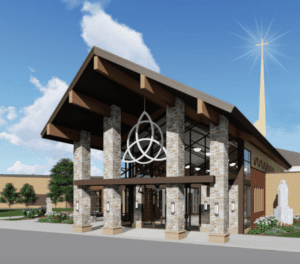
The Trinity knot is also called the Triquetra (from the Latin for three corners) and is one of the best known symbols in Celtic culture. In the Christian faith, the three points of the Trinity knot represent the Holy Trinity of Father, Son and Holy Spirit. Occasionally, you may see the Trinity knot enclosed within a circle as a means of emphasizing unity or eternity. Christians believe the Triquetra began with monks who brought the symbol with them along with their faith when converting the Celts. This symbol was also chosen for our church building because it emphasizes that we are many parts in one body, we are the many living stones that make up the Church of Jesus Christ, we are made one through the Death and Resurrection of Christ. Together we are strong in the love of God.
Mary Shrine & Statues
Catholics have statues of Jesus, Mary and the saints in our churches, to honor them and preserve their memory, just like our nation does with statues of presidents and war heroes. Catholics often decorate statutes of Mary with roses and flowers to honor her memory. Sometimes we sing songs about Mary or carry a statue or picture of her in a procession. To a casual observer it may appear that Catholics are worshiping a statue of Mary, but this is simply a way that Catholics show her honor. God honored Mary too, by sending the angel Gabriel to tell her she was “full of grace” and ask her to bear his son. Jesus also honored Mary, was obedient to her as a child, and did what she asked when he turned the water into wine at the wedding at Cana. Jesus especially honored Mary from the cross when he gave his mother to us “Woman, behold your son” and to his disciple “behold your mother”. John 19: 26-27Our statues of Jesus, Mary and the saints are ways that Catholics honor and preserve their memory, through visual means in our every day life. Remember the expression, “out of sight, out of mind?” As Catholics, we never want Jesus, and Mary, and the example of the saints to be out of sight or out of mind, but be forever enduring in our hearts, and in our every day lives.
Music & Song
The importance of music in biblical religion is shown very simply by the fact that the verb “to sing” (with related words such as “song) is one of the most commonly used words in the Bible. It occurs 309 times in the Old Testament and thirty-six in the New. We find the first mention of singing in the Bible after the crossing of the Red Sea. Israel has now been definitively delivered from slavery. Year by year, at the Easter Vigil, Christians join in the singing of this song. They sing it in a new way as their song, because they know that they have been “taken out of the water” by God’s power, set free by God for authentic life.
The singing of the Church comes ultimately out of love. It is the utter depth of love that produces the singing. “Cantare amantis est,” says St. Augustine, singing is a lover’s thing. In so saying, we come again to the trinitarian interpretation of Church music. The Holy Spirit is love, and it is he who produces the singing. He is the Spirit of Christ, the Spirit who draws us into love for Christ and so leads to the Father. Ultimately, liturgical music rises up out of the love that responds to God’s love made flesh in Christ, the love that for us went unto death. After the Resurrection, the Cross is by no means a thing of the past, and so this love is always marked by pain at the hiddenness of God, by the cry that rises up from the depths of anguish, Kyrie eleison, by hope and by supplication. But it also has the privilege, by anticipation, of experiencing the reality of the Resurrection, and so it brings with it the joy of being loved. That is why singing in the liturgy has priority over instrumental music, though it does not in any way exclude it. It goes without saying that the biblical and liturgical texts are the normative words from which liturgical music has to take its bearings.
Holy Water & Fonts
The rich symbolism of this ancient tradition of holy water and its fonts evokes, primarily, three things. First, the blessed holy water reminds us of our baptism. By receiving baptism, we were adopted into God’s family, grace was poured into our souls – we became “temples of the Holy Spirit” (1 Corinthians 6:19). By making this reconnection, the Church invites us to thank God, to remind ourselves of our dignity as beloved children of God, and to take comfort in knowing that we truly are members of this divine family, members of the Body of Christ.
Second, holy water is what the Church calls a “sacramental.” The Catechism defines sacramentals like this (#1667):
Holy Mother Church has, moreover, instituted sacramentals. These are sacred signs which bear a resemblance to the sacraments. By them men are disposed to receive the chief effect of the sacraments, and various occasions in life are rendered holy.
The “effect” that is signified by blessing ourselves with holy water is, basically, cleansing. As we enter the Church and prepare to worship God through the liturgy, we want our minds and hearts to be pure, to be purified from sin and selfishness. This gesture is a way of giving physical and material expression to this desire for repentance and purification. This purification helps us focus on God, and focus on praying and worshipping God. That intensified focus opens our souls to receive the grace God wants to send us through the sacramental liturgy.
Third, locating the holy water fonts at the entrance to our churches symbolizes the difference between ordinary space and sacred space. When we enter into the holy place, we bless ourselves with holy water. We leave behind the worldly noise and confusion that surrounds our normal, everyday activities, and we are refreshed and renewed by the order, silence, reverence, and beauty of the sacred space, the space used only for prayer and worship. It helps us make the transition from normal business into the special activity of divine worship.
Tabernacle
The tabernacle is a liturgical furnishing used to house the Eucharist outside of Mass. This provides a location where the Eucharist can be kept for the adoration of the faithful and for later use (e.g., distribution to the sick). It also helps prevent the profanation of the Eucharist. Thus the law requires, “The tabernacle in which the Eucharist is regularly reserved is to be immovable, made of solid or opaque material, and locked so that the danger of profanation may be entirely avoided” (Code of Canon Law 938 §3).
The word tabernacle means “dwelling place.” Any place someone dwells is a tabernacle. The term is also sometimes used for a temporary dwelling place. Thus the tent-like sanctuary that the Jews used before the Temple was built was called the Tabernacle, because God dwelt there. Similarly, for the feast of Sukkot the Hebrews erected temporary shelters to live in for the festival, which is often called “the feast of tabernacles” or “the feast of booths” as a result.
The use of a tabernacle in Catholic churches rests solely on the doctrine of the Real Presence of Christ in the Eucharist, the knowledge that Jesus himself is truly present under the appearances of bread (and wine). In other words, the tabernacle is not used in a symbolic way, to symbolize God’s presence among us, but in a real way (like the Tabernacle of the Old Testament) to house and protect the real presence of God in the Eucharist. This is also why Catholics genuflect when passing the tabernacle. We do so in honor of the real presence of Christ present in the Eucharistic bread reserved and protected in the tabernacle.
Without the Eucharist, the tabernacle is simply an empty gold box.
Candles
The word “candle” comes from the Latin verb candeo, meaning “to shine, glow, or burn.” As early as the eighth century, the word “candle” was introduced into the English language specifically in relation to liturgical practices. Candles have always been used in the Church in a symbolic way. From ancient times the lighted candle has been seen as a symbol of the light of Christ. This is clearly expressed at the Easter Vigil, when the deacon or priest enters the darkened church with the single Easter candle. Jesus came into our world of sin and death to bring the light of God to us. He expressed this idea clearly in the Gospel of John: “I am the light of the world; he who follows me will not walk in darkness, but will have the light of life” (John 8:12). There are some who also point to the use of candles as a remembrance of the early Christians who celebrated Mass in the catacombs by candlelight. It is said that this should remind us of the sacrifice they made as well as the possibility that we too could be in a similar situation, celebrating Mass under threat of persecution.
Besides offering a meditation on light, candles in the Catholic Church are traditionally made of beeswax. According to the Catholic Encyclopedia, “The pure wax extracted by bees from flowers symbolizes the pure flesh of Christ received from His Virgin Mother, the wick signifies the soul of Christ, and the flame represents His divinity.” The requirement to use candles that are, at the very least partially made with beeswax, is still present in the Church on account of this ancient symbolism.
In the end, while candles may seem antiquated and unnecessary, the Church believes that the natural beauty of candles can have a spiritual impact on our souls. Whether it be the Easter, Altar, Processional, Votive, Advent or Sanctuary candles, they all point to the truth of the burning love that God has for us, and how that love should shine in and through us to bring light, warmth and continued progression in holiness for others and self. The Church, in her wisdom, realizes the power behind the symbolism of using candles and how they can reignite a drooping spirit and fill it with the fire of divine love.
Sanctuary 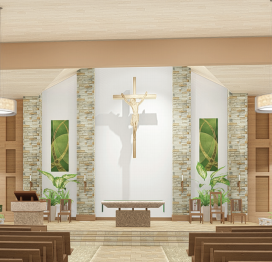
“Sanctuary is a word derived from the Latin sanctuarium, which is a container for keeping something in—in this case holy things or cherished people. The meaning was extended to places of holiness or safety, in particular the whole demarcated area, often many acres, surrounding a Greek or Roman temple. Similar usage may be sometimes found describing sacred areas in other religions. In Christian churches “sanctuary” has a specific meaning, covering part of the interior, covered below.
In the Roman Catholic Church the sanctuary is the area, often raised, in the front of the church where the altar, the ambo, the celebrant’s chair and, in many churches, the tabernacle are located. Separated from the nave (the part of a Catholic Church where the laity prays and worships. The word “nave” comes from the Latin “navis,” meaning ship. We, the people of God, are regarded as passengers on a ship destined for heaven). The sanctuary is the place reminiscent of the Holy of the Holies, that is, the inner sanctuary of the temple described in the Old Testament.
The General Instruction of the Roman Missal defines the sanctuary as “the place where the altar stands, where the word of God is proclaimed, and where the priest, the deacon and other ministers exercise their offices” (No. 295). The sanctuary’s elevation above the nave floor serves to enhance the view of the laity but also exemplifies a special, sacred place.
The St. Ambrose sanctuary is officially poured and set! Several weeks ago, the ‘old’ sanctuary was removed to lower it a step, re-form it and strengthen it so that it can hold the weight of the altar, ambo and baptismal font. Over the past few weeks, it was reformed and last week the final remaining section was poured. You can now see the final shape, height and dimensions for the ‘new’ sanctuary. It’s great!
Altar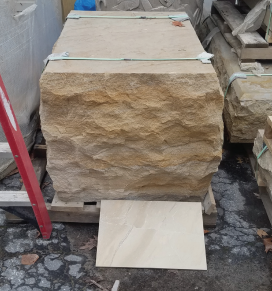
The altar is the table on which the Sacrifice of the Mass is offered. One or more relics of martyrs, or other saints, are commonly set into the altar. In the primitive church and in the catacombs, the altar was usually a niche covered with a slab over the tomb of a martyr. The Catechism of the Catholic Church states plainly that the “Christian altar is the symbol of Christ himself, present in the midst of the assembly of his faithful” (CCC 1382).
Because of this truth the altar is given the most prominent location in a church, occupying a place which is truly the center toward which the attention of the whole congregation of the faithful naturally turns. This is also why the priest and deacon kiss the altar at the beginning and end of Mass; to reverence Christ the Redeemer whose sacrifice of love set us free for heaven. It is recommended to be made of stone, echoing the scriptures which repeatedly call Christ a rock and cornerstone (see 1 Pt 2:4, 1 Cor 10:4, Eph 2:20).
Our new altar will also follow an ancient custom of the Church of having five carved crosses (one in each corner and one in the center) in the top of the altar to represent the five wounds of Jesus Christ.
The stone for the altar arrived this week! It is in the church, acclimating to the warmer temperature and will be installed this coming week! It’s exciting to see it all come together!
Baptismal Font
The Sacrament of Baptism is one’s entrance in the Body of Christ, the Family of the Church. Through this sacrament we follow Christ’s command to baptize all nation’s in the name of the Father, and of the Son, and of the Holy Spirit (Matthew 28:19). Through either the pouring of water or immersion in it, the person is washed clean of original sin and made a dwelling of the Holy Spirit.
The placement and designs of the font has changed and adapted over the millennium (many fonts are 8 sided to show the 8th day of Resurrection as the day of re-creation in Christ). Whatever the design, this font is a privileged place of encounter with Christ. Our new baptismal font will be in a place of prominence in the sanctuary and allow for full participation of the assembly in the baptismal rite.
The stone for our baptismal font arrived a few weeks ago to Norbert Koehn’s workshop in South Euclid. He is preparing it for delivery to St. Ambrose in a few weeks! The stone is so heavy, it needs additional foundation work, and will be placed before any flooring is installed. Norbert will smooth out the interior of the font and waterproof it. He will do the plumbing connections for it once onsite.
Ambo
A word of Greek origin, supposed to signify a mountain or elevation quoting the following from the Prophet Isaiah (40:9): “Get thee up upon a high mountain, thou that brings good tidings to Sion: lift up thy voice with strength”. And in the same connection lie also alludes to Our Blessed Lord preaching from a mountain: “He went up into a mountain–and opening his mouth he taught them” (Matthew 5:1, 2).
Ambos are believed to have taken their origin from the raised platform from which the Jewish rabbis read the Scriptures to the people, and they were first introduced into churches during the fourth century, were in universal use by the ninth, reaching their full development and artistic beauty in the twelfth century.
An ambo is an elevated desk or pulpit from which in the early churches and basilicas the Gospel and Epistle were chanted or read, and all kinds of communications were made to the congregation; and sometimes the bishop preached from it. Originally there was only one ambo in a church, placed in the nave, and provided with two flights of steps; one from the east, the side towards the altar; and the other from the west. From the eastern steps the subdeacon, with his face to the altar, read the Epistles; and from the western steps the deacon, facing the people, read the Gospels. The inconvenience of having one ambo soon became manifest, and in consequence in many churches two amboes were erected.
Our new ambo at St. Ambrose will be a stunning, strong, permanent structure to proclaim God’s Holy Word and intercede on behalf of God’s Holy People.
Bells:
Since the earliest days of the Church, bells have been used to call the faithful to prayer and remind them of their heavenly vocation. From their lofty chambers in bell towers (or through the miracle of modern technology) there floats down upon the city or the countryside the melodious harmony of bells, calling people to worship within the sacred building, and expressing, as well as dead matter may, the sentiments both of joy and sorrow which alternately sway human hearts.
Bells were in existence and used in the days of Moses. Small bells were even part of the scheme of ornamentation of therobes of the high priest. It can be claimed for the Church in her adoption of that which was already established, and the abolishing of superstitious uses of earlier ages by the blessing and consecration with which she dedicates the sonorous metal to the service of God. In 400 AD , St. Paulinus of Nola introduced church bells into the Christian Church. In 604 AD, Pope Sabinian officially sanctioned their usage.
By the early Middle Ages, church bells became common in Europe. They were first common in northern Europe, reflecting Celtic influence, especially that of Irish missionaries. Church bells call us to prepare for Masses, toll in remembrance of the dead at a funeral and peal joyously to announce a wedding or other special event. Traditionally there is a special ringing of church bells daily at 6am, 12 noon and 6pm to remind us to pray the Angelus in recognition of the Word becoming Flesh when Gabriel brought glad tidings to the Virgin Mary. Our new system at St. Ambrose will also allow us to continuing playing hymns throughout the day in thanksgiving to God for his goodness and to lift up our prayers and needs to his mercy.
Processional Cross:
The Processional Cross, also called a processional crucifix, is a familiar object to most of the Catholic faithful. The designs and style may vary, but it is a crucifix, large enough for the congregation to see it during a procession, which is usually mounted on a long handle. It is used in most liturgical processions within the Catholic Church. It is carried at the front of the procession, with the figure of the crucified Christ facing the direction the procession is moving; this is because all Christians are followers of Christ. After the cross is carried to the altar, it may be placed on or near the altar or, if a fixed altar cross is already in place, it may be put away.
The use of processional crosses in the Liturgy dates back several centuries, and the origin of this tradition is commonly credited to St. Augustine of England who died in 604. In the 8th century, St. Bede wrote Historia ecclesiastica gentis Anglorum (Ecclesiastical History of the English People), and in this document he included a description of Augustine of England, first Archbishop of Canterbury, carrying a processional cross.
As mentioned, in the past either a cross alone or a true crucifix was used. For example, a preserved processional cross from 12th century Ireland was decorated finely with copper, rock crystal, and gold filigree, but seems to have never had a figure of Christ attached. Other early processional crosses were sometimes highly decorated but did not include a corpus. And a plain cross, not bearing an image of the Crucified Lord, was used during Lent in the Middle Ages. But in the mid-to-later Middle Ages the use of the true crucifix became more prominent. While the term processional cross is used, it is now meant to indicate a cross bearing an image of the Crucified Christ, and not a plain cross.
Crucifix:
As Catholics, the crucifix plays a special role in the liturgical tradition of the Church. The Church requires that a crucifix be visible during the celebration of Mass to remind us of the sacrifice of Jesus on the altar of the cross, which is made present for us each time we celebrate the Holy Eucharist. A simple cross doesn’t have the same visual or spiritual impact. Catholics also believe that our Lord is risen, but we also need to be reminded of what Christ had to endure before the Resurrection could take place, namely his Passion and Death on the cross.
The crucifix helps us better understand and appreciate our “theology of redemption.” When some type of suffering comes our way, the image of the crucifix can give us spiritual strength and inspiration. We know that the Crucifixion of Jesus is a one-time event that can never occur again in history. But it is an event which should never be forgotten. Sometimes key moments and events in history which can never be repeated are memorialized forever through a piece of artwork. As Christians, when we gaze lovingly upon the image of our suffering Lord on the cross, we are reminded of the depth of Christ’s redeeming love for us. A plain cross just doesn’t have the same impact. The crucifix is a visual reminder of Christ’s battle over sin, a battle in which He is the Victor! What thoughts go through your mind when you look at the image of the crucifix? We know what Christ was thinking about when He hung upon the cross. He was thinking about us!
On some crucifixes a skull and crossbones are shown below the corpus, referring to Golgotha (Calvary), the site at which Jesus was crucified, which the Gospels say means in Hebrew “the place of the skull.” Medieval tradition held that it was the burial-place of Adam and Eve, and that the cross of Christ was raised directly over Adam’s skull, so many crucifixes manufactured in Catholic countries still show the skull and crossbones below the corpus. The “INRI” found on many depictions of the crucifixion is an abbreviation for the Latin “Iesus Nazarenus, Rex Iudaeorum” (“Jesus the Nazarene, King of the Jews”), posted on the cross by order of the Roman procurator, Pontius Pilate.
Stations of the Cross:
The Stations of the Cross or the Way of the Cross, also known as the Way of Sorrows or the Via Crucis, refers to a series of images depicting Jesus Christ on the day of his crucifixion and accompanying prayers. The stations grew out of imitations of Via Dolorosa in Jerusalem which is believed to be the actual path Jesus walked to Mount Calvary. The object of the stations is to help the Christians faithful to make a spiritual pilgrimage through contemplation of the Passion of Christ.
The devotion of praying the Stations started with the Francisican friars in the Holy Land. The practice of erecting stations spread quickly and went through different stages culminating in Pope Pius IX allowing the stations in all Catholic Churches.
The Church Steeple:
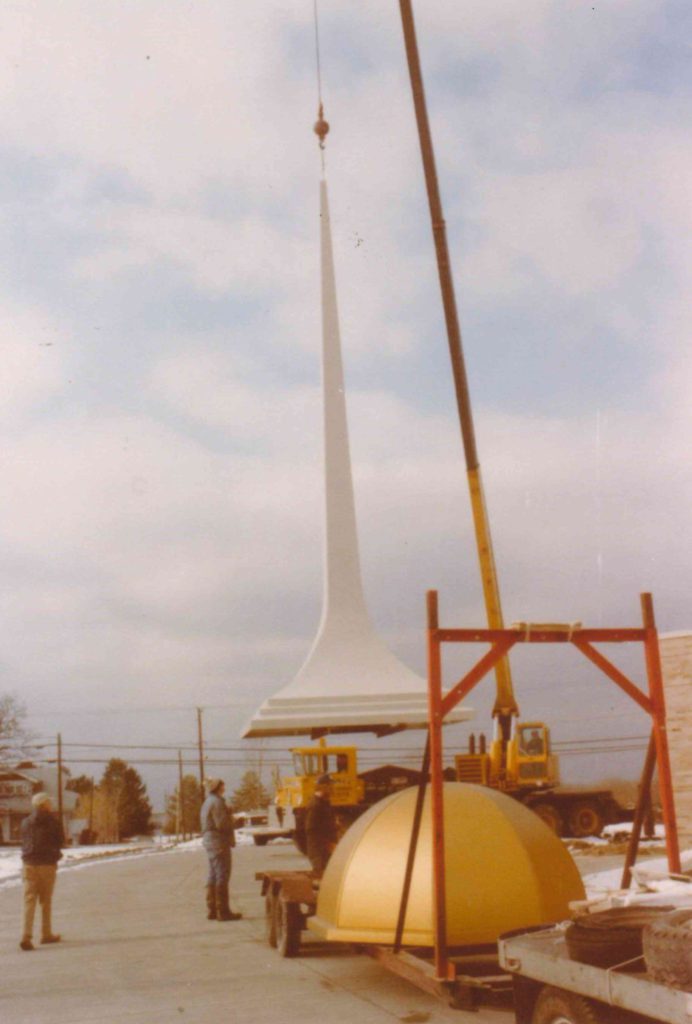 The spiritual significance of these structures comes straight from the Bible. The Psalmist speaks about God as a tower, saying, “Raise me up, set me on a rock, for you are my refuge, a tower of strength against the foe” (Psalm 61:3-4). In Proverbs we read, “The name of the Lord is a strong tower; the righteous man runs into it and is safe” (Proverbs 18:10). Steeples were also used to remind a local community to remain focused on God. Other secular buildings were usually built lower than the church steeple, making the local church the highest and most important building of the town. You couldn’t go anywhere in town without seeing the steeple and as a result be reminded about your duty to God – to center our lives on Christ.
The spiritual significance of these structures comes straight from the Bible. The Psalmist speaks about God as a tower, saying, “Raise me up, set me on a rock, for you are my refuge, a tower of strength against the foe” (Psalm 61:3-4). In Proverbs we read, “The name of the Lord is a strong tower; the righteous man runs into it and is safe” (Proverbs 18:10). Steeples were also used to remind a local community to remain focused on God. Other secular buildings were usually built lower than the church steeple, making the local church the highest and most important building of the town. You couldn’t go anywhere in town without seeing the steeple and as a result be reminded about your duty to God – to center our lives on Christ.
The steeple of our Church will be totally removed Friday, October 12, 2018. After 36 years, the steeple is in great need of a complete rebuild. The original fabricator will be doing the work. It will take a huge crane and two-man lifts to make this happen. It will be quite the sight!!!
The Sacristy:
A sacristy is a room for keeping vestments and other church furnishings, sacred vessels, and parish records. The word “sacristy” derives from the Latin sacristia, sometimes spelled sacrastia, which is in turn derived from sacrista (“sexton, sacristan”), from sacra (“holy”). In the sacristy there is a specialized basin called a piscina, the drain of which is properly called a “sacrarium” in which the drain flows directly into the ground to prevent sacred items such as used baptismal water or particles of the Eucharist from the sacred vessels from being washed into the sewers or septic tanks.

